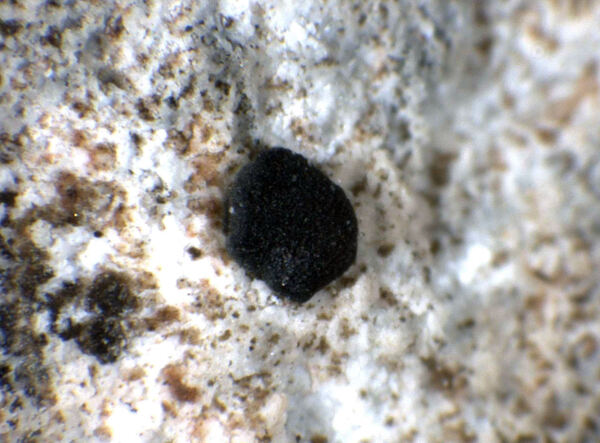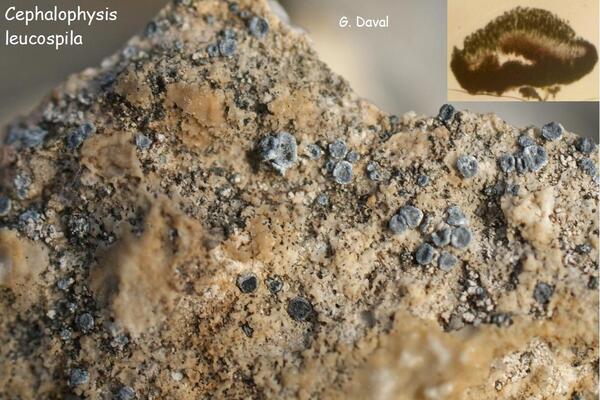Cephalophysis leucospila (Anzi) H. Kilias & Scheid.
in Kilias, Herzogia, 7: 183, 1985. Basionym: Lecidea leucospila Anzi - Comm. Soc. Critt. Ital., 1, 3: 156, 1862.
Synonyms: Cephalophysis leucospila var. caelivicina (Poelt & Hertel) H. Kilias & Scheid.; Lecidea mashiginii Lynge; Lecidea subtumidula Nyl.; Lecidea ultima Th. Fr.; Lecidea ultima var. caelivicina Poelt & Hertel
Distribution: N - Frl, Ven (Hertel & Schuhwerk 2010), TAA (Hertel & Schuhwerk 2010, Nascimbene & al. 2022), Lomb. C - Abr (Nimis & Tretiach 1999). S - Camp (Aprile & al. 2003b, Garofalo & al. 2010).
Description: Thallus endosubstratic or thinly episubstratic, continuous or rimose-areolate, whitish, sometimes reduced to a few scattered granules around the apothecia, without a distinct prothallus. Medulla thin, white, I-. Apothecia lecideine, 0.1-0.5(-0.8) mm across, black, glossy, epruinose, with a flat to slightly convex disc and a thin, soon excluded proper margin. Proper exciple brown-black in outer part, reddish brown to pale winde-red within; epithecium bright blue-green, up to 35 µm high, N+ purple-red; hymenium pale emerald green (mostly in upper part) to almost colourless 50-70 µm high, I+ blue; paraphyses weakly coherent, easily separable in water, simple or rarely furcate and anastomosing, submoniliform in upper part, to 1.7-2.2 µm thick at mid-level, the apical cells markedly clavate, 5-8(-10) µm wide; hypothecium olive-brown to brown-black, K+ reddish, N+ purple-red. Asci 8-spored, subcylindrical-clavate, bitunicate, thickened at apex with a broad internal beak, I+ blue in the outer part of the apex, approaching the Fuscidea-type. Ascospores 1-celled, hyaline, ellipsoid, 6-11 x 4-7 µm. Pycnidia black, immersed. Conidia short-bacilliform, 3-5 x c. 1 µm. Photobiont chlorococcoid. Spot tests; K-, C-, KC-, P-, UV-. Chemistry: thallus without lichen substances.Note: an arctic-alpine, circumpolar species found on limestone and dolomite on exposed, steeply inclined faces above treeline; probably more widespread in the Alps. The var. caelivicina (Poelt & Hertel) H. Kilias & Scheid., typical of the nival belt, is known from the Austrian Alps.
Growth form: Crustose
Substrata: rocks
Photobiont: green algae other than Trentepohlia
Reproductive strategy: mainly sexual
Commonnes-rarity: (info)
Alpine belt: rare
Subalpine belt: extremely rare
Oromediterranean belt: extremely rare
Montane belt: absent
Submediterranean belt: absent
Padanian area: absent
Humid submediterranean belt: absent
Humid mediterranean belt: absent
Dry mediterranean belt: absent

Predictive model
Herbarium samples
Growth form: Crustose
Substrata: rocks
Photobiont: green algae other than Trentepohlia
Reproductive strategy: mainly sexual
Commonnes-rarity: (info)
Alpine belt: rare
Subalpine belt: extremely rare
Oromediterranean belt: extremely rare
Montane belt: absent
Submediterranean belt: absent
Padanian area: absent
Humid submediterranean belt: absent
Humid mediterranean belt: absent
Dry mediterranean belt: absent

Predictive model
| Herbarium samples |
 Index Fungorum
Index Fungorum
 GBIF
GBIF




